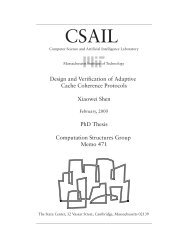Proof of Freshness - Computation Structures Group - MIT
Proof of Freshness - Computation Structures Group - MIT
Proof of Freshness - Computation Structures Group - MIT
Create successful ePaper yourself
Turn your PDF publications into a flip-book with our unique Google optimized e-Paper software.
For the same reason as in the tree-based scheme we require the bound (5). This reduces (4) to I ≈ NuT/q<br />
(and reduces (8) to LI ≈ N/q, hence, L ≈ 1/(uT) which is consistent with our intuition that 1/(uT) is<br />
approximately equal to the expected time (1 − u)/u between two consecutive requests <strong>of</strong> devices <strong>of</strong> the same<br />
client divided by T). These approximations combined with (9) yield<br />
and<br />
hence,<br />
dT<br />
dq<br />
T ≈ qγ + βN log(NuT/q) (10)<br />
≈ γ + βNq<br />
ln 2T<br />
dT<br />
dq<br />
<br />
1 dT T<br />
−<br />
q dq q2 <br />
,<br />
≈ γ − βN/(q ln 2)<br />
1 − βN/(T ln 2) .<br />
This shows that, if βN/(T ln 2) < 1, then T is minimized for q defined by γ = βN/(q ln 2), that is, q =<br />
βN/(γ ln 2). Substituting this value for q in (10) yields<br />
T ≈ βN/ ln 2 + βN log(uγT(ln 2)/β) = βN log(euγT(ln 2)/β). (11)<br />
Notice that this solution for T is an increasing function in N. So, the restriction T ≤ 1/(2u) <strong>of</strong> (5) is<br />
equivalent to the requirement that N ≤ N ∗ for N ∗ computed as the solution <strong>of</strong> equation (11) with T = 1/(2u).<br />
That is,<br />
N ≤ 1/(2uβ log(e(ln 2)γ/(2β))) = 1/(2uβ log(0.94γ/β). (12)<br />
Notice that (1 − (1 − u) β ) ≈ uβ is equal to the probability that one <strong>of</strong> the devices <strong>of</strong> a given client requests<br />
to start the verification and reservation protocol within the amount <strong>of</strong> time needed for the transmission <strong>of</strong> one<br />
atomic piece <strong>of</strong> data. From (7) and (12) we infer that the log-based scheme can serve many more clients than the<br />
tree-based scheme if β ≪ γ.<br />
D Appendix: Analysis <strong>of</strong> a Hybrid Scheme<br />
In order to bound the size <strong>of</strong> freshness pro<strong>of</strong>s to a constant size in the log-based scheme, we propose a hybrid<br />
solution between the log-based and tree-based scheme. The idea is to move nodes into the tree-based scheme if<br />
they correspond to clients for which the size <strong>of</strong> a pro<strong>of</strong> <strong>of</strong> freshness in the log-based scheme gets too large. As<br />
soon as a client reserves a new time value, then the client is moved back to the log-based scheme.<br />
A data structure D in the hybrid solution contains both the log-based data structure as well as the tree-based<br />
data structure:<br />
D = (s[1], T [1], s[2], T [2], . . . , s[tc], T [tc]; tc, T ′ ),<br />
where T ′ is a balanced authenticated search tree which not only allows modifications but also insertions and deletions<br />
and where (s[1], T [1], s[2], T [2], . . . , s[tc], T [tc]; tc) is exactly the data structure <strong>of</strong> the log-based scheme<br />
in which each signature s[t] = Sign(sk, H(t||Root[t]||Root ′ )) not only signs the root Root[t] <strong>of</strong> T [t] but also<br />
another root Root ′ . In s[t] the value Root ′ represents the root <strong>of</strong> T ′ at the moment <strong>of</strong> its appearance at time value<br />
t. In particular, Root ′ in s[tc] is equal to the current value <strong>of</strong> the root <strong>of</strong> T ′ .<br />
Let K be some constant which indicates the worst-case allowable number <strong>of</strong> atomic pieces <strong>of</strong> data constituting<br />
a single pro<strong>of</strong> <strong>of</strong> freshness. As in the log-based scheme, the update algorithm U(D, I) increments the current<br />
time value and appends to D a new authenticated search tree for I together with a signature <strong>of</strong> its root. Let tc be<br />
the incremented current time value and let k be the largest integer such that<br />
log N +<br />
tc<br />
t=tc−(k−1)<br />
17<br />
log #T [t] ≤ K, (13)
















